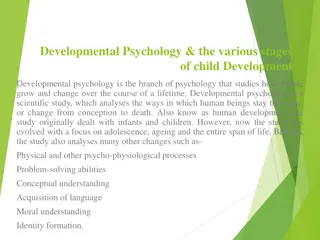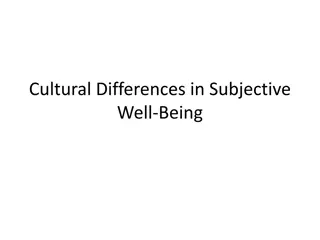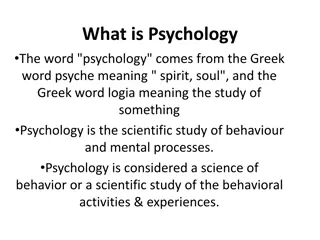Understanding the Importance of Positive Psychology and Subjective Well-Being
Positive psychology emphasizes the significance of happiness, satisfaction, and well-being in people's lives. Subjective well-being (SWB) focuses on individuals' evaluations and feelings about their lives rather than just objective conditions. Enhancing SWB is not only about feeling better but also holds practical value in improving overall success and health. People with greater SWB tend to be more successful in various life domains and exhibit qualities like altruism and strong social connections.
Download Presentation

Please find below an Image/Link to download the presentation.
The content on the website is provided AS IS for your information and personal use only. It may not be sold, licensed, or shared on other websites without obtaining consent from the author. Download presentation by click this link. If you encounter any issues during the download, it is possible that the publisher has removed the file from their server.
E N D
Presentation Transcript
Positive Psychology Introduction
Introduction That the vast majority of the people on this earth prefer more happiness to less happiness and prefer lives with which they are more often satisfied than dissatisfied. Being happy and satisfied with one s life is of great importance to the vast majority of people all over the world.
Introduction The experience of joy, contentment, or positive well- being, combined with a sense that one s life is good, meaningful, and worthwhile
Introduction Subjective well- being (SWB) is a psychological construct concerned not with what people have or what happens to them but with how they think about and feel about what they have and what happens to them.
Introduction The study of subjective well- being makes a distinction between the objective conditions of someone s life and that person s subjective evaluations of and feelings about his or her life. Plenty of relatively rich, healthy people are miserable, and plenty of relatively poor or unhealthy people lead lives of meaning and joy. Average SWB is greater in some relatively poor countries than in some relatively rich countries.
Introduction In addition, as rich nations have become richer over the past several decades the average SWB of their citizens has, in general, not increased. It feels good to be happy and satisfied with life, but enhancing people s sense of well- being and life satisfaction is not simply about making them feel better; enhancing subjective well- being has practical value.
Introduction People with greater subjective well- being are more successful in many life domains, and their success is at least partly due to their greater sense of well- being. They are more social, altruistic, and active; they like themselves and other people better, have stronger bodies and immune systems, and have better conflict resolution skills.
Conceptions of Subjective Well- Being SWB is a psychological construct concerned with what people think about and how they feel about their lives. In hedonic conceptions, SWB is defined by the balance of pleasant and enjoyable versus unpleasant events in a person s life. A good life is one in which there is more pleasure and enjoyment than pain and suffering, regardless of the sources of these events and experiences.
Conceptions of Subjective Well- Being The individual s moral attributes, values, virtues, goals, achievements, and contributions to other people and society are largely irrelevant. What matters is to what extent the person enjoys his or her life, generally feels good as opposed to bad, experiences pleasure as opposed to pain and discomfort, and is satisfied versus dissatisfied with his or her life.
Conceptions of Subjective Well- Being In hedonic conceptions, the individual is the sole judge of his or her happiness and life satisfaction. The opinions of other people (including philosophers and psychologists) as to whether the person is leading a good or meaningful life are irrelevant.
Conceptions of Subjective Well- Being Eudaimonic conceptions of well- being emphasize the idea that we flourish by fully exercising our human capacities The term eudaimonia to refer primarily to the idea that a good life involves achieving the best that is within us, each according to his or her unique talents and capacities
Conceptions of Subjective Well- Being In this conception, well- being is determined not by the quality of one s sensual and emotional experiences but by the extent to which one is living up to one s potential; making progress toward attaining one s valued goals; and living a life of meaning, purpose, and virtue.
Conceptions of Subjective Well- Being Ryff s model proposes six components: self- acceptance, positive relations with others, personal growth, purpose in life, environmental mastery, autonomy.
Conceptions of Subjective Well- Being Keyes (2006) model proposes the same six as Ryff but adds five components of social well- being acceptance, actualization, contribution, coherence, integration.
Conceptions of Subjective Well- Being Ryan and Deci s model focuses mainly on the three components of autonomy, competence, Relatedness.
Empirical Evidence Research on the distinction between hedonic and eudaimonic conceptions and measures of well- being suggests that they are strongly related. Various studies have found correlations ranging from .76 to .92 between hedonic and eudaimonic measures of SWB.
Which Conception Is Better? Many discussions of the distinctions between hedonic and eudaimonic SWB implicitly or explicitly assume that there is a moral hierarchy for distinguishing different types of subjective well- being and that eudaimonic well- being is more morally valid, ethical, virtuous, or authentic than hedonic well- being.
Which Conception Is Better? Cultures differ in their conceptions of SWB and the value they place on SWB. For example, people in Eastern (mainly East Asian) cultures are more likely to equate SWB with the experience of low- arousal emotions such as contentment, peace, and tranquility rather than the more high- arousal emotions of happiness and joy that are more highly valued in Western cultures.
Which Conception Is Better? Western and individualist cultures also value pride and self- satisfaction more highly than Eastern and collectivist cultures do. In Eastern conceptions of SWB, self- transcendence is more important than the self- enhancement that is more characteristic of Western conceptions of SWB, harmony is more highly valued than mastery, and valuing suffering is more important than avoiding suffering.
Which Conception Is Better? In addition, life satisfaction is more strongly related to autonomy, feelings of meaning, and personal growth in Western cultures than in Eastern ones. SWB in collectivist cultures is more closely tied to contributions to family and group than to the enjoyment of individual achievements.
Which Conception Is Better? Among Koreans, the word most frequently associated with happiness is family , while among Americans it is smile Koreans also associate happiness with social words more than Americans do and are more likely than Americans to associate happiness with family than with friends
Which Conception Is Better? But these findings cannot prove that one conception of SWB is more or less correct, more or less ethical or moral, or more or less authentic than another. Research cannot tell us whether conceiving of and measuring SWB as a combination of positive affect, negative affect, and life satisfaction (a hedonic conception) is more or less correct, true, moral, virtuous, or authentic.
Theories of Subjective Well- Being Life Circumstance Theories: Life circumstance theories propose that SWB is mainly the result of the number of a person s positive and negative life circumstances both day- to- day life experiences (major and minor) and favorable or unfavorable demographic factors such as socioeconomic status, education, and physical health.
Theories of Subjective Well- Being From this perspective, people who were born into advantageous circumstances and to whom good things happen more often than bad things will have greater SWB than less advantaged, less fortunate people. In addition, life circumstance theories propose that overall SWB and life satisfaction are the result of satisfaction with a variety of life domains (work, family, etc.) in which positive and negative events, experiences, and emotions may occur.
Theories of Subjective Well- Being Dispositional/Construal Theories: Dispositional theories propose that SWB primarily results not from life circumstances themselves but from biological or temperamental factors that influence behaviors and cognitions such as interpretations and appraisals of life circumstances and events that, in turn, influence SWB.
Theories of Subjective Well- Being Dispositional theories are also construal theories because they propose that cognitive construals (beliefs, perceptions, and interpretations) of life events and circumstances mediate the effect of biological or temperamental factors on SWB. Research suggests that genetic predisposition may account for as much as 50% of the differences among people in their current SWB and as much as 80% of long- term differences.
Theories of Subjective Well- Being Most of this research has been conducted on the so- called Big 5 personality traits: neuroticism, extraversion, agreeableness, conscientiousness, and openness to experience . The strongest personality trait predictors of SWB are neuroticism and extraversion. Agreeableness, conscientious, and openness to experience are less powerful predictors.
Theories of Subjective Well- Being Neuroticism is the general disposition to experience negative emotions such as anxiety and depression, so it is not surprising that people higher in neuroticism generally report lower SWB than those who are lower in neuroticism. Openness to experience (e.g., preference for variety, intellectual curiosity) has a modest relationship with SWB but one that is weaker than those of the other four Big 5 traits.
Theories of Subjective Well- Being Extraversion is strongly associated with SWB; more extraverted (socially outgoing) people generally report greater SWB than more introverted (solitary) people. People high in agreeableness (congenial, easy to get along with, considerate) usually report greater SWB than people lower in agreeableness, possibly because they are more likely to promote harmony in relationships and less likely to promote conflict.
Theories of Subjective Well- Being Highly conscientiousness people (organized, dependable, responsible, persistent) report greater SWB than less conscientious people, probably because they are generally more persistent in striving toward meaningful goals, have greater social connectedness, and are more physically active, all of which are associated with greater SWB.
Theories of Subjective Well- Being Support for the dispositional component also can be found in the research on enduring mental health that shows that a small minority of people (perhaps 17%) go through life without ever experiencing a formally diagnosable mental disorder.
Theories of Subjective Well- Being Evolutionary theories of SWB are variations of dispositional/construal theories that propose that some evolved human tendencies move people toward greater. SWB but that others make it difficult for people to attain and sustain SWB. SWB- enhancing needs include the needs for strong mating bonds, friendship, kinship, and cooperation with others.
Theories of Subjective Well- Being Other evolved tendencies, however, make SWB difficult to attain and sustain. Humans evolved in environments where material resources were always scarce and where status was strongly associated with reproductive success. Therefore, the human brain has been programmed to keep humans striving for status and prestige, such as through the acquisition of material goods.
Theories of Subjective Well- Being Because of this programming, people continually ignore information about what actually does and does not enhance their SWB. Other evolved barriers to SWB that have been proposed by evolutionary theorists include the differences between ancestral and modern environments (e.g., urbanization, mass communication) that can lead to subjective distress.
Theories of Subjective Well- Being A final evolutionary consideration is the ability of people to quickly adapt to new circumstances. With respect to subjective well- being, this adaptation process is referred to as the hedonic treadmill. It refers to the tendency of people to return to their particular baseline of subjective well- being following increases or decreases in positive or negative life events, respectively.
Theories of Subjective Well- Being The problem for subjective well- being seekers is that new pleasures and positive life events may cause a short burst of enhanced SWB but will soon lose their luster as people get used to them and return to their baseline SWB. This process can lead people to seek out even more and bigger pleasures in the quest for enhanced SWB.
Theories of Subjective Well- Being Both life circumstance and dispositional/construal theories of SWB have merit and are best viewed as complementary rather than mutually exclusive. Studies are showing that physical health, daily hassles, world assumptions, and constructive thinking all directly influence SWB, supporting both life circumstance theories (health, hassles) and dispositional/construal theories (assumptions, thinking).
Measuring Subjective Well- Being Some scales measure only the affective components of SWB, some measure only the life satisfaction components, and some measure both components. Others scales assess several or more components that are usually viewed as eudaimonic aspects of well- being.
Measuring Subjective Well- Being Measures that are primarily affective, especially those that assess more or less in- the- moment affect can be viewed as measures of experienced well- being, while measures of life satisfaction, because they require the evaluation of life events and experiences over relatively long periods of time, can be viewed as measures of evaluated well- being.
Measuring Subjective Well- Being Tripartite Model of Hedonic SWB The most well- researched conception and measure of hedonic SWB is the tripartite model which views SWB as consisting of positive affect, negative affect, and life satisfaction, which can be both general (satisfaction with life overall) and domain- specific (satisfaction with specific domains of life such as work and relationships).
Measuring Subjective Well- Being Measures of life and domain satisfaction are cognitive measures based on evaluations of and beliefs about one s life, while measures of positive and negative affect are affective or emotional measures, concerned with how often people experience pleasant and unpleasant feelings.
Measuring Subjective Well- Being The relationship between overall life satisfaction and domain- specific satisfaction is both bottom- up and top- down. In a bottom- up relationship, people first develop satisfaction with specific life and domains and then formulate an overall life satisfaction from these domain satisfactions. In a top- down relationship, people first develop a sense of overall life satisfaction that then leads them to positively or negatively evaluate specific life domains.
Measuring Subjective Well- Being Measures of Affect and Happiness The most commonly used measure of affect is the Positive and Negative Affective Schedule (PANAS) which includes 10 positive affect adjectives (e.g., interested, enthusiastic, inspired) and 10 negative affect adjectives (e.g., distress, upset, afraid), all rated on a 5- point scale.
Measuring Subjective Well- Being Measures of Life Satisfaction The Satisfaction with Life Scale contains 5 items assessing overall life satisfaction.
Problems in the Measurement of SWB A long- standing problem in SWB research has been the lack of a consensus on how to define and measure SWB, which has resulted in difficulty comparing and summarizing results across studies. The different conceptions and measures of eudaimonic well- being also make comparisons across studies of eudaimonic well- being difficult.
Problems in the Measurement of SWB The vast majority of measures of SWB ask people what they think and feel. Can people accurately evaluate and honestly report their level of SWB? How do we know that people who say they are happy are actually happy?
Problems in the Measurement of SWB Most studies of SWB are cross- sectional correlational studies in which measures of SWB. correlational studies cannot be used to determine the direction of causality among the variables examined. People s mood states and some contextual factors may influence SWB.
Problems in the Measurement of SWB All measures of psychological constructs are vulnerable to problems of reification ( eyle tirme). The biggest danger posed by trait reification is that it can lead researchers to exaggerate the importance of their results, which can lead to bad science and bad public policy.























